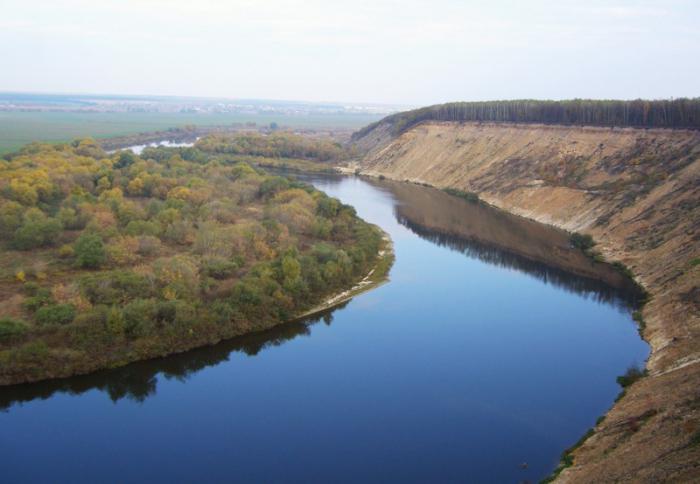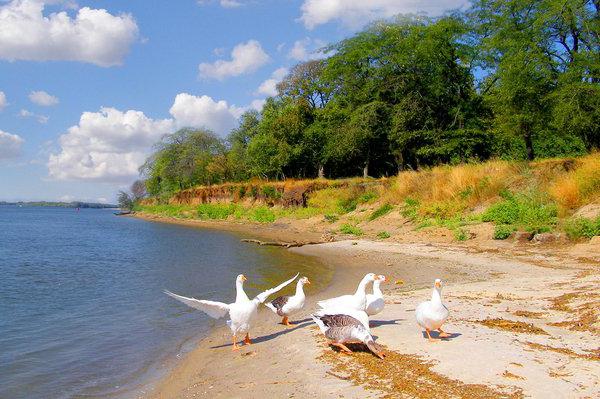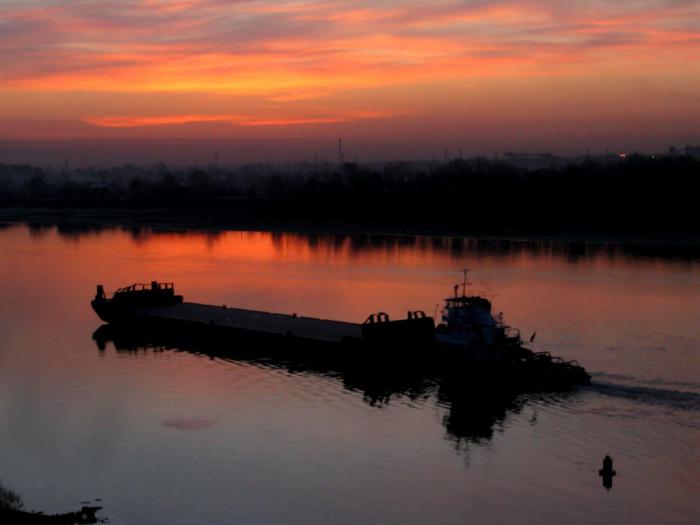The Don River (Russia) is one of the greatestEuropean part of the country. The area of its catchment is 422 thousand square meters. km According to this indicator, in Europe Don is second only to the Danube, Dnieper and Volga. The length of the river is about 1870 km.

History
The river Don in the past was called Tanais.The ancient Greeks invented a legend according to which a young man with that name drowned in this reservoir because of unhappy love. The origin of the name “Don” is associated by researchers with the Scythian-Sarmatian word “danu”, meaning “river, water”.
Ancient Greek authors are often called Tanais thenDon River, then Seversky Donets. The latter was then closer to the civilized world, therefore, for example, Ptolemy considered the Don (Girgis) a tributary of the North Donets (Tanais). At the mouth of the river Tanais, a Greek colony of the same name was created.
Interesting information left Ritter in the book.Vorhalle. It turns out that the Sea of Azov in ancient times did not exist, and the Don River fell into the Black Sea in the Kerch Strait area. According to the researcher Peytinger, at the source of the Don there is an inscription saying that this is the “River Tanais, separating Europe from Asia”.
The Normans in their sagas referred to as Don Vanacvisle.Count Potocki has gathered many legends and myths about this river. Dmitry Ivanovich Donskoy in 1380 defeated the Tatar-Mongol army on the Kulikovo field, in the place where the river Nepryadva flows into the Don, for which he received his sonorous nickname.
It is known that from time immemorial at the mouth of the Donwas located the city of Tana. It was built by colonists from Greece and was subordinate to the Kingdom of Bosporus. This commercial blooming city belonged to the Genoese, the Venetians. Only in 1475, Tana was conquered by the Turks and renamed Azov (Azof). After that, all trade and embassy affairs of the Russian state with Tsargrad and the Crimea were carried out mainly along the Don River.
Don - the cradle of the Russian fleet: the military, which arose through the efforts of Peter the Great in 1696, and the merchant, which appeared under Catherine II in 1772.

Source
The river Don in the Tula region has its origins.Its source is a small streamlet of Urvanka, flowing in the park of the city of Novomoskovsk. At the beginning of the river there is a symbolic monument called the Source of the Don. The pond in this architectural complex is of artificial origin, it is powered from the local water supply.
Previously, lake Ivan was considered the source of the river, but itDon is not usually reported. The beginning of the river is sometimes called the Shatskoye reservoir, which is located north of Novomoskovsk, Tula region, but it is fenced off from the Don railway dam.

The nature of the riverbed and the valley
Don has a typical character for lowland riversvalleys and river beds. The river changes direction four times, bending around several geological obstacles. Its course has a longitudinal profile and a slight slope decreasing towards the mouth, the value of which is 0.1 degrees. The general direction of the Don flow is from north to south. Almost over its entire length, the river is surrounded by a developed valley, has a wide flood plain and a great many branches. In the lower reaches, the Don reaches a width of 12-15 km. In the vicinity of the town of Kalach-on-Don, the valley of the river is compressed by the spurs of the Volga and Middle-Russian uplands. There is no floodplain on this small stretch by the river.
The valley of the river has an asymmetrical structure.The right bank of the Don is quite high, in some places it reaches 230 meters, the left - low and flat. River flow is calm and slow. No wonder the river was called "Silent Don." Local Cossacks respectfully call the river “Don-father”. Hydrograph researchers consider the river to be one of the oldest in the European part of Russia.
Mouth of the river don
Don flows into the Sea of Azov - Taganrog Bay.Starting from the city of Rostov-on-Don, the river creates a delta, the area of which is 540 square meters. km At this point, the river bed splits into a multitude of channels and branches. The largest of them are Egurcha, Perevoloka, Bolshaya Kuterma, Bolshaya Kalancha, Old Don, Dead Donets.

Mode
With a large catchment area, the Don is differentrelatively low water content. This is due to the fact that the river basin is completely located within the steppe and forest-steppe zones. The water content of the Don is much lower than that of the rivers of the Northern Region (Pechora, Northern Dvina), is approximately 900 m3/from.
The Don water regime is also typical of rivers,occurring in the steppe and forest-steppe climatic zones. The river is powered mainly by snow (up to 70%), as well as by soil and rain. In the spring, the Don is characterized by high floods, while in the rest of the year its level is quite low. Since the end of the spring rise and until the next flood, the flow rate and water level fall.
The magnitude of the fluctuation of the water level in the Don on everythingThe length is significant and is 8-13 meters. The river spreads heavily in the floodplain, especially in the lower reaches. Usually Don has two waves of high water. The first appears during the entry of melt snow water from the lower part of the river (Cossack or cold water), the second arises due to inflow from the upper Don (warm water). If snowmelt is late, both waves merge, and then the flood is stronger, but less long.
The Don River is covered with ice in the late fall or the very beginning of winter. At the end of March, the river opens at the bottom, then the ice breaks along the entire length and in the upper reaches.

Hydrographic division of the river
It is not an easy task to carry out the river Donbecause in terms of its size it ranks third among all the rivers in the European region of Russia. Hydrographically, the Don is usually divided into three sections: Upper, Middle and Lower.
From the source to the confluence of the river Tikhaya Sosna of the Voronezh region, the Upper Don flows. Here it has a narrow valley and winding, with shallows, bed.
The middle section of the Don - from the mouth of the Quiet Pine to Kalach-on-Don. In this place the valley of the river greatly expands. The Middle Don is completed by a reservoir built in the area of the village of Tsimlyanskaya.
Lower Don flows from the city of Kalach-on-Don to the mouth.Behind the Tsimlyansky reservoir, the river has a wide (from 12 to 15 km) valley and a spacious floodplain. The depth of the Don in some places reaches fifteen meters.
The largest tributaries of the river are Voronezh, Ilovlya, Medveditsa, Khoper, Bityug, Manych, Sal, Seversky Donets.

Using
At a distance of 1,590 kilometers from the mouth to the city of Voronezh, the Don River is navigable. The largest ports are located in the cities of Azov, Rostov-on-Don, Volgodonsk, Kalach-on-Don, Liski.
In the vicinity of the town of Kalach, the Don approachesVolga - is located about 80 kilometers away. The two great Russian rivers are connected by the Volga-Don navigable canal, the construction of which became possible after the creation of the Tsimlyansk reservoir.
В районе станицы Цимлянская возведена плотина the length of the ridge is 12.8 km. The hydraulic structure raises the river level by 27 meters and forms the Tsimlyanskoe reservoir, stretching from the village of Golubinskaya to the city of Volgodonsk. The capacity of this reservoir is 21.5 km3, area - 2600 km2. When the dam works hydroelectric. Water from the Tsimlyansk reservoir irrigates the Salsk steppes and other steppe areas of the Volgograd and Rostov Regions.
Below the Tsimlyanskaya HPP, at a distance of about 130kilometers, the depth of the Don River is maintained with the help of hydropower stations with locks and dams: Kochetkovsky, Konstantinovsky and Nikolaevsky. The oldest and most famous of them - Kochetkovsky. It is 7.5 kilometers below where the Don River receives the tributary of the Northern Donets. The hydrosystem was built in 1914-1919 and reconstructed in 2004-2008.
The depth necessary for shipping in the Don below the Kochetkovsky hydroelectric complex is maintained by systematic excavation from the bottom of the river (dredging).

Fauna in the river basin
The river Don is rich in fish.Among small species there are asp, rudd, roach, perch. In addition, large and medium fish species are found in the river: pike, catfish, pike perch, bream. However, due to river pollution and a strong recreational load, the fish reserves of the Don are constantly decreasing.
On the banks of the river, in the marshes, are found waterfrogs, toads, comb and common newts. The inhabitants of the places where the river Don is located are the water and common snakes, the marsh turtle and the green toad. The latter live not only along the river, but also on the territory of meadows growing in its basin.
Intensive plowing of the fields around the Don led tothe fact that such species as marmots, saigas, steppe antelopes, and wild horses have disappeared in this area. Back in the 60s-70s of the last century, baibaks, roes, wild boars and muskrats could be found near the tributaries of the river. Now in the basin of the Don rodents live: a mouse, a gopher, a large jerboa, a river beaver. Small predators are also found: forest and steppe ferrets, weasels, minks and river otters. In the river basin live bats.
Over the past 100-150 years, the number of birdsnesting near the river, greatly reduced. The swans, geese, eagles, golden eagles, falcons, peregrine falcons, carnivores, ospreys, white-tailed eagles disappeared. Rest on the Don River is traditionally associated with duck hunting. Among the birds still preserved are waders and ducks, crows, thrush-like warblers. Less common are storks, herons and cranes-bellows. In the bird migration season you can see the brant, the gray goose and others.
Flora
It is known that Peter the Great involved a forest withthe shores of the Don for the construction of ships used in the Russian-Turkish battles. By the twentieth century, the vast majority of meadows in the river basin was plowed. A variety of trees have been preserved in the vicinity of floodplain swamps: buckthorn brittle, alder gummy, fluffy birch, willow. Along the river there is a marsh cinquefoil, kistvetsvetny kerast, sedge, marsh horsetail, reed.












